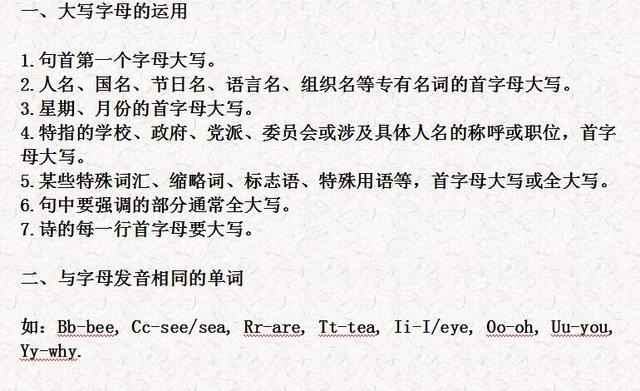
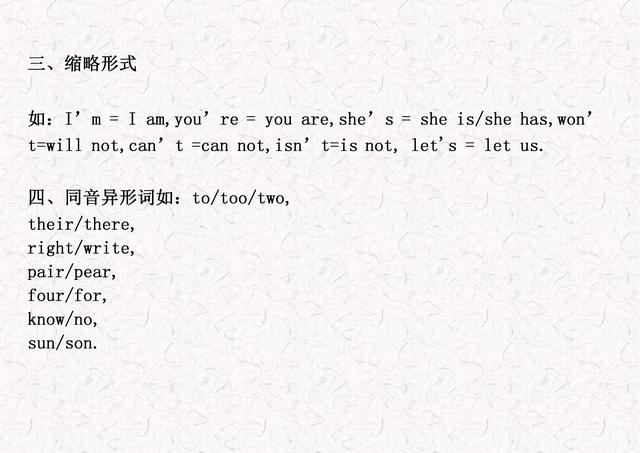
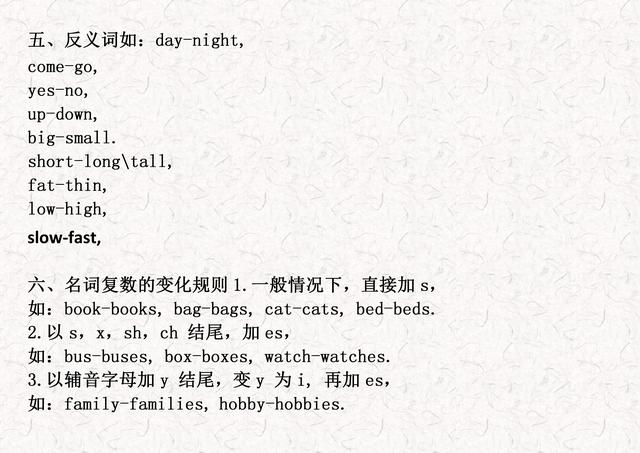
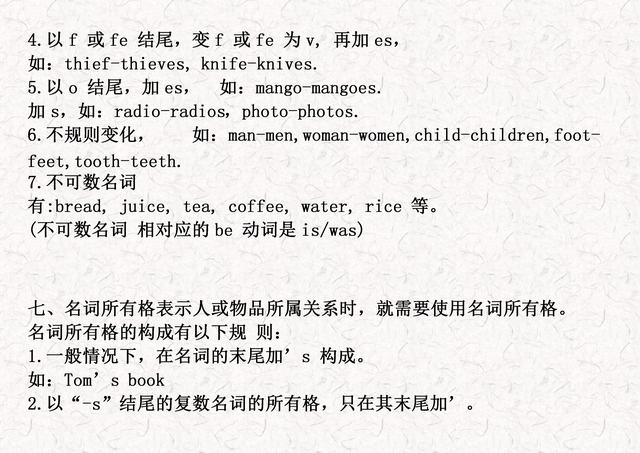
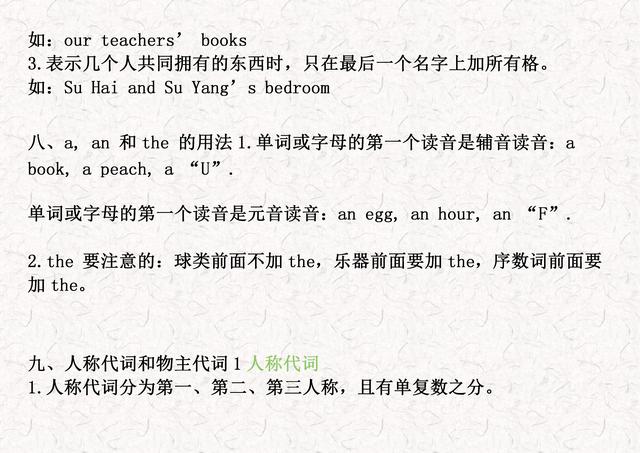
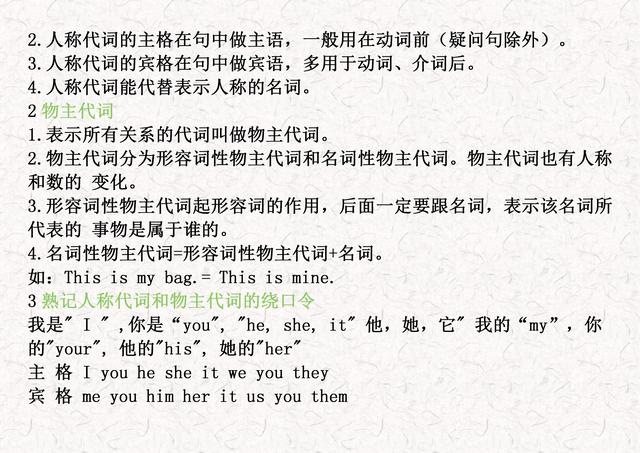
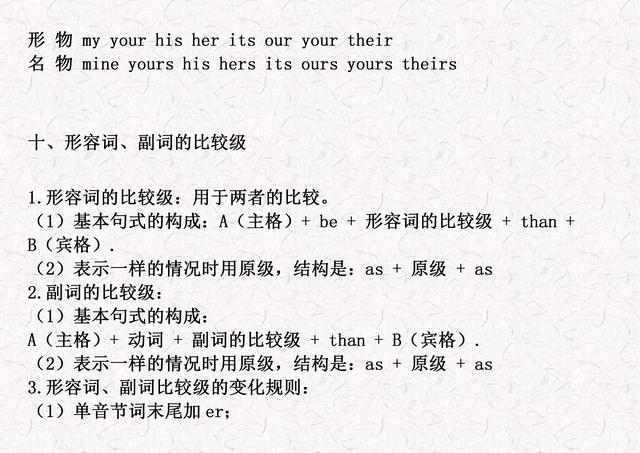
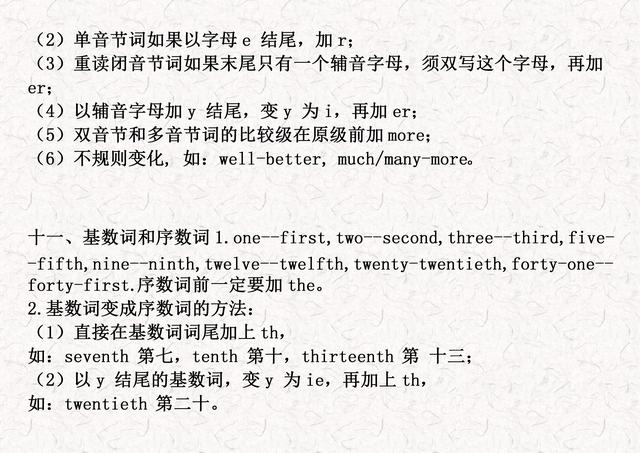
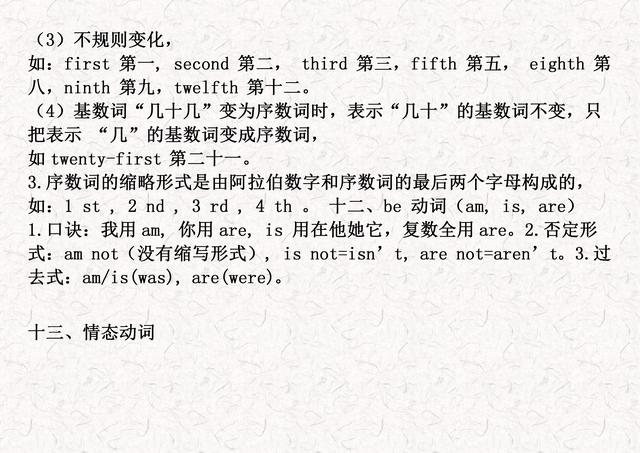
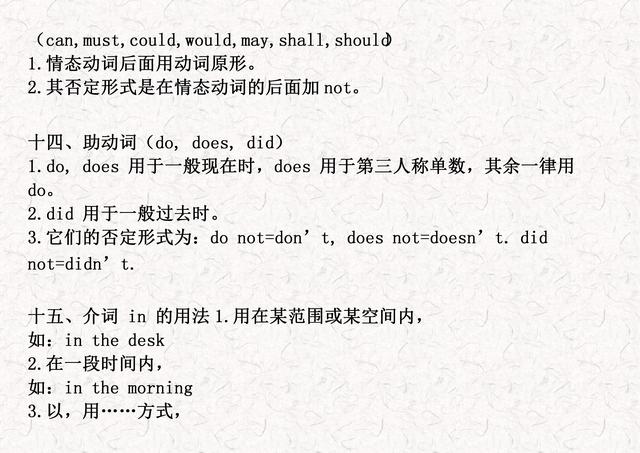
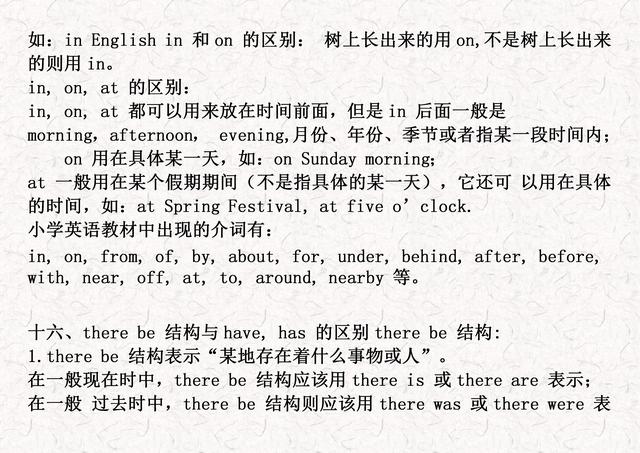
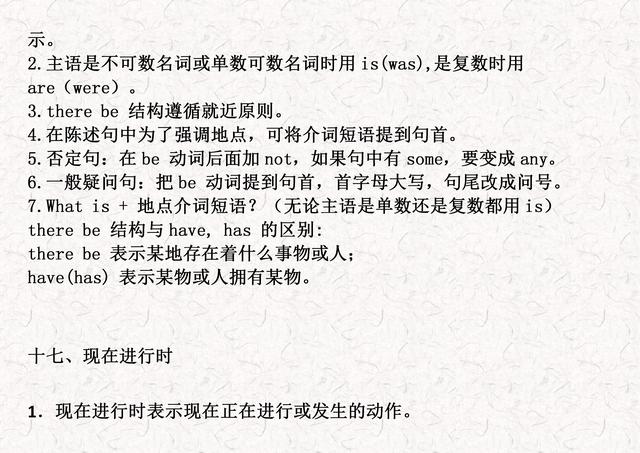
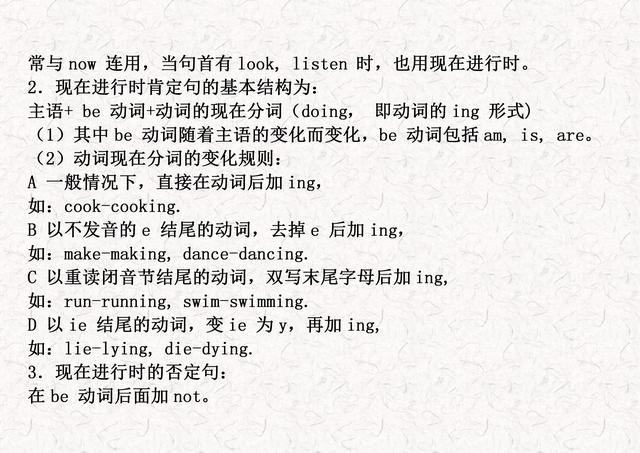
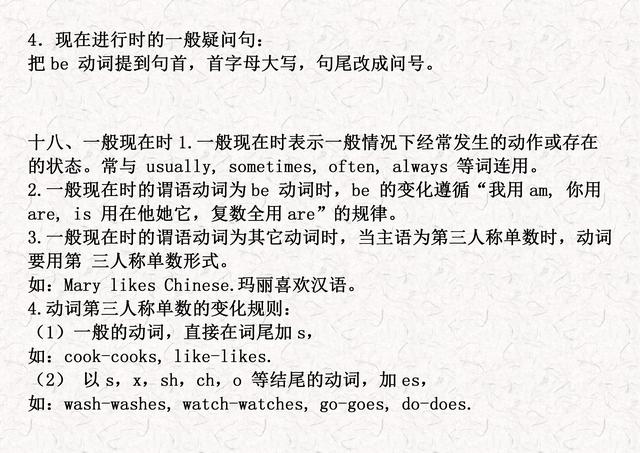
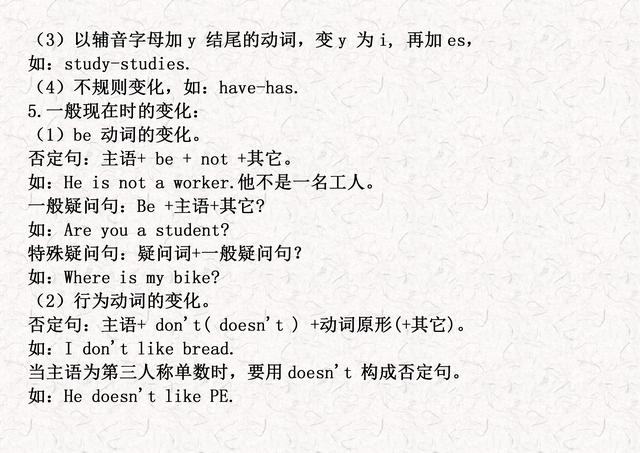
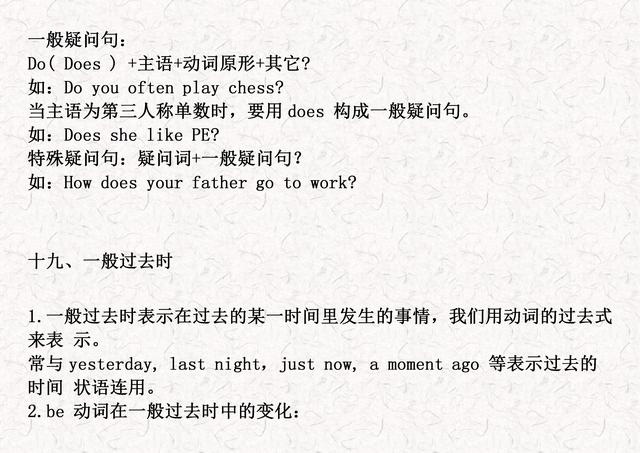
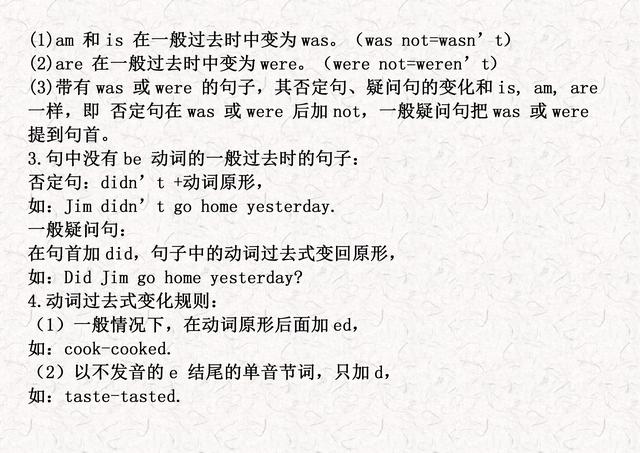
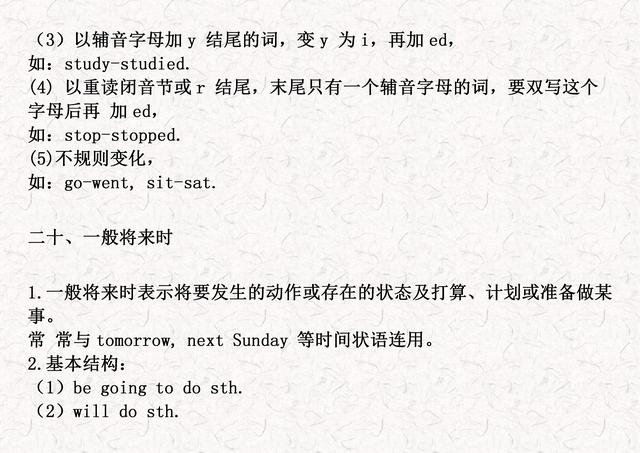
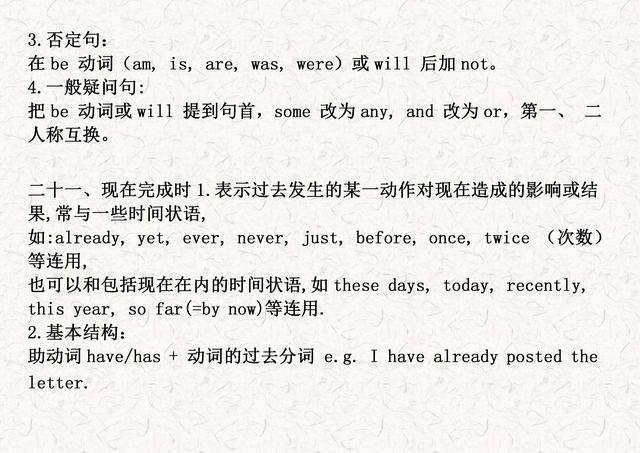
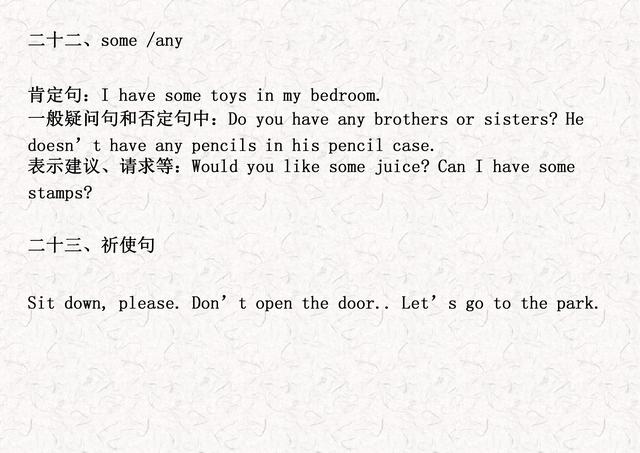
一、单词
Unit 1
学习文具:
pen (钢笔) pencil (铅笔) pencil-case ( 铅笔盒) ruler(尺子) eraser(橡皮) crayon (蜡笔) book (书) bag (书包) sharpener (卷笔刀) school (学校)
Unit 2
身体部位:
head (头) face( 脸) nose (鼻子) mouth (嘴) eye (眼睛) leg (腿) ear (耳朵) arm (胳膊) finger (手指) leg (腿) foot (脚) body (身体)
Unit 3
颜色:
red (红色的) yellow (黄色的) green (绿色的) blue (蓝色的) purple (紫色的) white (白色的) black (黑色的) orange (橙色的) pink (粉色的) brown (棕色的)
Unit 4
动物:
cat (猫) dog (狗) monkey (猴子) panda (熊猫) rabbit( 兔子) duck (鸭子) pig (猪) bird (鸟) bear (熊) elephant (大象) mouse (老鼠) squirrel (松鼠)
Unit 5
食物:
cake (蛋糕) bread (面包) hot dog (热狗) hamburger (汉堡包) chicken (鸡肉) French fries (炸薯条) coke (可乐) juice (果汁) milk (牛奶) water (水) tea (茶) coffee (咖啡)
Unit 6
数字:
one (一) two (二) three (三) four (四) five (五) six( 六) seven (七) eight (八) nine( 九) ten( 十) doll (玩具娃娃) boat (小船) ball (球) kite (风筝) balloon (气球) car (小汽车) plane (飞机)
二.、对话
1、向别人问好应该说
A: Hello! (你好!)
B: Hi! (你好!)
2、问别人的名字应该说
A:What's your name? 你的名字是什么?
B:My name's Chen Jie. 我的名字是陈洁。
3、跟别人分手应该说
A: Bye. Good bye!(再见)
B: See you.(再见) Goodbye.(再见)
4、A: I have a pencil bag uler 我有一只铅笔书包尺子。
B: Me too . 我也有。
5、早上相见应该说
A: Good morning. 早上好!
B: Good morning! 早上好!
6、下午相见应该说
A: Good afternoon! 下午好!
B: Good afternoon! 下午好!
7、跟新朋友第一次见面
A: Nice to meet you! 见到你很高兴。
B: Nice to meet you,too! 见到你也很高兴!
8、A: Let's go to school! 让我们一起去上学!
B: OK! 好的。
9、看见久未见面的朋友或者别人身体不舒服,你该这么打招呼
A: How are you ? 你好吗?
B: Fine,thank you我很好,谢谢你。
10、A: Let's paint. 让我们画画。
B: Great! 棒极了!
11、A: Look I have a rabbitmonkey. 看,我有一只兔子猴子。
B: CoolSuper Great Wow! 酷超级好棒极了好厉害.
12、你想看下别人的东西,你该这么说
A: May I have a look? 我可以看一看吗?
B: Sure. Here you are! 当然可以。给你!
13、请别人吃东西,你该这么说
A: Have some French fries. 吃一些炸薯条。
B: Thank you. No, thanks. 谢谢你。不,谢谢你。
14、A: What do you like? 你喜欢什么?
B: I like hot dogs. 我喜欢热狗。
15、你想吃点东西,你该说
A: Can I have some chicken? 我能吃一些鸡肉?
B: Sure here you are. 当然可以,给你。
16、A: Thank you. 谢谢你。
B: You're welcome. 别客气。
17、A:B: Happy birthday. 生日快乐!
B: Thank you. 谢谢。
18、A: How old are you? 你几岁啦?
B: I'm nine. 我九岁了。(要用数字回答哦!)
19、A: Let's eat the birthday cake. 让我们吃生日蛋糕
B: Great! 棒极了!
20、A: How many balloons gifts? 多少个气球礼物?
B: Four ten. 四/十。
三、句子
Unit 1
1.show me your pencil / ruler/ eraser/ crayon/ pen.
让我看看你的铅笔/尺子/橡皮/蜡笔/钢笔。
2.open your pencil--case. 打开你的铅笔盒。
close your book .合上你的书。
show me your sharpener. 让我看看你的卷笔刀。
carry your bag. 背起你的书包。
go to school . 去上学。
Unit 2
3.Touch your head./ nose/ eye/ mouth/ ear.
摸摸你的头/鼻子/眼睛/嘴巴/耳朵。
4. Clap your hands. 拍拍你的手。
Snap your fingers. 打响你的手指。
Wave your arms. 挥挥动你的胳膊。
Cross your legs. 翘翘你的双腿。
Shake your body. 扭扭你的身体。
Stamp your foot. 跺跺你的脚。
Unit 3
5.Show me your red/ blue / green / yellow / purple crayon.
给我看看你的红/蓝/绿/黄/紫色蜡笔。
6.Black, black. Stand up. 黑色,黑色,站起来(起立)!
Pink , pink. Sit down. 粉红色,粉红色,坐下!
Brown, brown. Touch the ground. 棕色,棕色,摸摸地板。
Orange, orange. Touch your head. 橙色,橙色,摸摸你的头。
White, white. Turn around. 白色,白色,转个圈。
Unit 4
7. Act like a cat/ duck/ panda/ monkey/ rabbit/ dog.
模仿小猫/鸭子/熊猫/猴子/兔子/小狗表演。
8. Hunt like a mouse. 像老鼠一样搜寻。
Walk like a elephant. 像大象一样走路。
Climb like a bear. 像狗熊一样爬。
Fly like a bird. 像小鸟一样飞。
Jump like a squirrel. 像松鼠一样跳。
Unit 5
9 .Show me your hamburger. 让我看看你的汉堡包。
Pass me the French fries. 把炸薯条递给我。
Cut the bread. 切面包。
Eat the hot dog. 吃热狗。
Smell the chicken. 闻闻鸡肉。
Make the cake. 做蛋糕。
10.pour the water 倒水。
Smell the coffee 闻闻咖啡。
Taste the tea 尝尝茶。
Show me the milk 让我看看牛奶。
Drink the juice 喝果汁。
11.bounce the ball.拍拍球。
fly the kite. 放风筝。
throw the plane.扔出飞机。
hold the doll.抱娃娃。
Drive the car.开车。
blow up the balloons.吹气球。
第二部分
一、语法易错点
1. a, an的选择: 元音字母开头的单词用an,辅音字母开头的单词用a.
2. am , is , are的选择: 单数用is , 复数用are. I 用 am , you 用 are.
3. have , has 的选择: 表示某人有某物.单数用has , 复数用have. I ,you 用 have .
4. there is, there are 的选择:表示某地有某物,某人.单数用there is , 复数用there are.
5. some, any 的选择:肯定句用some, 疑问句和否定句用any.
6. 疑问词的选择:what (什么) who (谁) where (哪里) whose (谁的) why(为什么)when(什么时候)which(哪一个)how old (多大) how many (多少)how much(多少钱)
二、形容词比较级
当我们需要对事物作出比较时,需要用到比较级。比较级的句子结构通常是:
什么 + 动词be (am , is , are ) + 形容词比较级 + than(比)+ 什么,
如:
I'm taller and heavier than you. (我比你更高和更重。)
An elephant is bigger than a tiger. (一只大象比一只老虎更大。)
形容词的比较级是在形容词的基础上变化而来的,它的变化规则是::
① 一般的直接在词尾加er ,如 tall - taller , strong - stronger ,
② 以e结尾的,直接加r ,如 fine – finer ,
③ 以辅音字母加y结尾的,先改y为i再加er,如funny - funnier
④ 双写最后的字母再加er,如big – bigger, thin – thinner ,hot – hotter
☆注意☆
比较的两者应该是互相对应的可比较的东西。
典型错误:My hair is longer than you.(我的头发比你更长。)
比较的两者是我的头发,你(整个人),那么比较的对象就没有可比性.。
应该改为:My hair is longer than yours. 或My hair is longer than your hair.
三、动词过去式
动词的过去式的构成规则有:
A,规则动词
① 一般直接在动词的后面加ed:如 worked , learned , cleaned , visited
② 以e结尾的动词直接加d:如 lived , danced , used
③ 以辅音字母加y结尾的动词要改y为i再加ed(此类动词较少)如 study – studied carry – carried worry – worried (注意play,stay不是辅音字母加y,所以不属于此类)
④ 双写最后一个字母(此类动词较少)如 stopped
B,不规则动词(此类词并无规则,须熟记)小学阶段要记住以下动词的原形和过去式:sing – sang , eat – ate , see – saw , have – had , do – did , go - went , take - took , buy - bought , get - got , read - read ,fly - flew , am/is - was ,
are - were , say - said , leave - left , swim - swam , tell - told , draw - drew , come - came , lose - lost , find - found , drink - drank , hurt - hurt , feel - felt
四、动词现在分词详解 动词的ing形式的构成规则
① 一般的直接在后面加上ing , 如doing , going , working , singing , eating
② 以e 结尾的动词,要先去e再加ing ,如having , writing
③ 双写最后一个字母的(此类动词极少)有:running , swimming , sitting , getting
五、小学英语人称代词主格及宾格
人称代词分为主格和宾格,主格和宾格区别:主格和宾格汉语意思相同,但位置不同。
Eg:I(主格)"我"-- me (宾格)"我"
主格在陈述句中通常放句首,宾格通常放在动词后或介词后,也就是说宾格,不放在句首。
Eg :I have a new car.( I 主格)
Excuse me (me 宾格)
I ask him to go (him 宾格)
They sit in front of me (me 宾格)
主格(8个):I 我you你 he他 she她 it它 we 我们you 你们they他(她、它)们
宾格(8个):me我 you你 him 他her她 it它 us我们 you你们 them他(她、它)们
六、句型专项归类
1.肯定句:是指用肯定的语气来陈述的句子,
如:I'm a student.
She is a doctor.
He works in a hospital.
There are four fans in our classroom.
2,否定句:含有否定词或表示否定意义词的句子,
如:I'm not a student.
He does not (doesn't) work in a hospital.
There are not (aren't) four fans in our classroom.
☆小结☆
否定句主要是在肯定句的基础上加上了否定词 "not".有动词be的句子则"not"加在be后面,可缩写成"isn't,aren't",但am not 一般都分开写。
没有动词be的句子则要先在主要动词的前面加上一个助动词(do,does,did),然后在它后面加上"not",你也可以把它们缩写在一起如"don't , doesn't , didn't )。
这三个助动词要根据人称和时态来选择,其中"does"只用于一般现在时主语是第三人称单数的情况,而"did"只用于一般过去时,不论主语是什么人称和数,都用"did" .
3、一般疑问句:指询问事实的句子,此类句子必须用"yes",或"no"来回答。
如:
Are you a student ?Yes, I am No, I'm not.
Is she a doctor? Yes, she is. No, she isn't.
Does he work in a hospital ?Yes, he does. / No, he doesn't.
Did you watch TV yesterday evening? Yes, I did. / No, I didn't.
☆小结☆
一般疑问句是在肯定句的基础上。
①把动词be调到首位,其他照写,末尾标点符号变成问号即可。
②没有动词be的句子则要在句首加上一个助动词(do,does,did)再把紧跟在后面的动词变回原形,末尾标点符号变成问号即可。
这三个助动词也要根据人称和时态来选择,其中"does"只用于一般现在时主语是第三人称单数的情况,而"did"只用于一般过去时,不论主语是什么人称和数,都用"did" 。
一般疑问句有个重要的原则就是问和答要一致,即问句里的第一个单词(助动词)和简略答句里的这个词是一致的。
4、特殊疑问句:以特殊疑问词(what , where , who , which , when , whose , why , how等)开头引导的句子,此类句子应该问什么就答什么,不能用"yes ,no"来回答。
如:
What is this?
Where are you going?
Who played football with you yesterday afternoon?
When do you usually get up?
Why do you like spring best ?
How are you?
☆小结☆
其中how又可以和其他一些形容词连用组成特殊疑问词组用来提问,如: how many(多少(数量)), how much(多少(钱)), how tall(多高), how long(多长), how big(多大), how heavy(多重)
例句:How many pencils do you have ?
How many girls can you see ?
how many 用来提问可数名词的数量,主要有以上三种搭配,
How many + 名词复数 + do you have 你有多少……
How many + 名词复数 + can you see 你能看见多少……
How many + 名词复数 + are there… 有多少……
七、完全、缩略形式
1、简缩形式的变法:把倒数第二个字母,通常是元音字母变成' 但are除外,are要把a打成' 。Eg:he is=he's they are=they're
2、简缩形式和完全形式的汉语意思相同。
3、把完全形式变成简缩形式时,一定要注意第一个字母的大小变化。Eg:What is =What's
4、记住一个特殊变化;let's =let us 让我们(不要把' 变成i) 5、记住:thisis 没有简缩形式this's(错误)
5、常见的缩略形式:
I'm=I am he's=he is she's=she is they're=they
are you're=you are there's=there is they're=they are
can't=can not don't=do not doesn't=does not
isn't=is not aren't=are not let's=let us
won't=will not I'll=I will wasn't=was not
 加载中,请稍侯......
加载中,请稍侯......
精彩评论